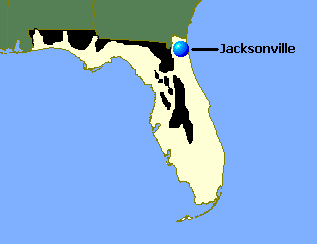| A Tale Of Two Cities | |||||||||||||||||||||||||||||||||||||||||||||||||||||||||||||||||||||||||||||||||||||||||||||||||||||||||||||||||||||||||||||||||||||||||||||||||||||||||||||||||||||||||||||||||||||||||||||||||||||||||||||||||||||||||||||||||||||||||||||||||||||||||||||||||||||||||||||||||||||||||||||||||||||||||||||||||||||||||||||||||||||||||||||||||||||||
| By Harry G. Lee | |||||||||||||||||||||||||||||||||||||||||||||||||||||||||||||||||||||||||||||||||||||||||||||||||||||||||||||||||||||||||||||||||||||||||||||||||||||||||||||||||||||||||||||||||||||||||||||||||||||||||||||||||||||||||||||||||||||||||||||||||||||||||||||||||||||||||||||||||||||||||||||||||||||||||||||||||||||||||||||||||||||||||||||||||||||||
| A pair of urban
centers in the American South, Jacksonville, Florida and Mobile,
Alabama, may seem odd choices for a Dickensian title, but, to
indulge the Southern idiom, "thereby hangs a tale," at least so it
seems malacologically. The two port cities have several common features such as altitude, latitude, rainfall, and temperature and are separated only by the breadth of North Florida. Interestingly, their native land snails are better known than those of any metropolis today. Eminent students like L. H. MacNeill, H. H. Smith, Bryant Walker, A. D. Brown, and Leslie Hubricht have provided data and taxonomic insights which have given stimulus and guidance to two Jacksonville Shell Club members, Mobilian Wayne Sullivan and the writer, in developing an understanding of the two land snail faunas. The report which follows is an attempt to summarize these data and understand the similarities and differences between the two. Table 1. lists all 80 species of terrestrial snail native to at least one of the cities (Here "Jacksonville" includes records for Clay, Duval, and St. Johns Counties; "Mobile" includes Mobile and Baldwin Counties). The columns separate those snails found in one, the other, or both places. While producing an obligingly perfect numerical symmetry (1 Jacksonville/3 both cities/1 Mobile) in this analysis, the data depicted in tables 2 and 3 show a remarkable contrast in the general distribution of those species limited to only one of the cities. |
|||||||||||||||||||||||||||||||||||||||||||||||||||||||||||||||||||||||||||||||||||||||||||||||||||||||||||||||||||||||||||||||||||||||||||||||||||||||||||||||||||||||||||||||||||||||||||||||||||||||||||||||||||||||||||||||||||||||||||||||||||||||||||||||||||||||||||||||||||||||||||||||||||||||||||||||||||||||||||||||||||||||||||||||||||||||
Go To Images Of The Seven Vertigo Species Listed Above Each city has four species of its own which are limited in general distribution to the adjacent coastal plain. Just what barriers exist between the Gulf and South Atlantic segments of the plain are not obvious, but clearly some land snail species have respect for them. Some of the "Jacksonville only" species clearly came here from tropical areas considerably to our south. Two of the three, Guppya gundlachii and Gastrocopta servilis, are quite widespread in the Caribbean area. Both cities are situated on the estuaries of large, but geologically different, rivers. Whereas the St. Johns never leaves the low coastal plain, the Mobile arises high in the Piedmont of Mississippi, Alabama, and Georgia. Those species comprising the majority of the "Mobile only" snails (10) are widespread on the Piedmont region and may well have reached Mobile via the Alabama or Tombigbee Rivers from remote upstream origins. Despite the special provenance of Mobile's alluvium, Jacksonville is able to even the species score in table 1 because of a greater degree of "endemnicity." Those species in the middle columns of tables 2 and 3 are rather limited in general distribution (for the sake of clarity, we might say limited to an area less than either state). Jacksonville "endemics" outnumber Mobile "endemics" by nine to two. The probable explanation of Jacksonville's lopsided advantage lies in the geologic history of the Florida peninsula. The Pleistocene epoch, beginning about 1,800,000 years ago and extending to about 25,000 BC, was characterized by rapid, severe changes in the Earth's surface temperatures. The changes were manifest, as most former highschoolers will recall, as the Ice Ages - with the advance and recession of great glaciers. The glacial ice was in the ultimate analysis derived from the seas, and sea levels fell and then rose as the glaciers advanced and then receded. As one might expect, shorelines were profoundly affected during the Ice Ages. One can first visualize the fall of sea level, exposing much of the Continental Shelf, during the glacial advances. What may come as a surprise is that at certain Pleistocene times the sea level was considerably higher than at present (less polar ice than today). In fact, during the warmest portion of the Pleistocene, the peninsula of Florida was inundated to the extent that there was only a nubbin of a peninsula and a few islands above water (black areas depicted on the map below).
Now, most evolutionists agree that the geographic isolation of populations of living things is a principal force in speciation. A glance at the map will make it clear how the Pleistocene epoch provided Florida geographic barriers on a grand scale. (Southern Alabama underwent much less extensive change - roughly like that of the Florida panhandle). Dr. Fred Thompson* has shown how extensive speciation occurred in the freshwater Hydrobiid snails during the Florida Pleistocene. The evidence seems to indicate that land snails, especially members of the family Polygyridae (the first six Jacksonville "endemics"), underwent a similar orgy of speciation, probably on islands created during the warmest phases. In looking at the moderately restricted ranges of certain "both cities" species (e.g., nos. 9, 11, 16, 28, 55, 57, 68, 70), one must also suspect a similar Pleistocene Floridian origin. Just why those nine Jacksonville "endemics" have reached North Florida and gotten very little further (including S. E. Georgia in one case) is a difficult question to answer, but it appears likely that there are habitats in Mobile in which most or all these species could thrive. There are probably subtle ecological barriers which impede the the already slow northern and western spread of these snail populations. A "snail's pace" is certainly a good characterization of the vagility (ability to move in a biogeographical sense) of any of our land mollusks. The lack of motility and perhaps some of the infective Florida sunshine possibly conspired to maintain 1 of 7 Jacksonville native land snails in complacent, relatively permanent isolation. *Thompson, Fred G. (1968) Aquatic snails of the family Hydrobiidae of Peninsular Florida University of Florida Press, Gainesville pp 268 plus xv, 69 fig. 3 tab. Note: Taxonomy updated on 5/3/2007 and 3/1/2011. |
